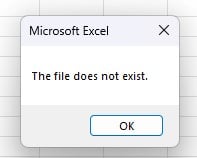What is IF NOT in VBA?
VBA IF NOT is a type of conditional statement that lets you do something if a specific condition is not met. It is a technique to see if a condition is false, and if it is, a block of code is run. VBA programs frequently use “IF NOT” to determine whether a given condition is true or not. Let us look at an example. In this example, we have a VBA subroutine named “CheckFileExistence,” which uses the VBA IF NOT statement to check whether a file exists in the provided path.

We declare a string variable filePath and assign it a file path (C:\Users\Vikram\Desktop\example.txt).
Next, we check to see if the file given by filePath exists using the “VBA IF NOT” statement and the Dir function. If the file does not exist, the Dir function returns an empty string, so the VBA IF NOT condition determines whether the output of Dir(filePath) is not an empty string. If the file exists, it displays a message saying, “The file exists,” and if not, it displays “The file does not exist.”

Table of Contents
Key Takeaways
- VBA IF NOT is used to check if a condition is false and execute code when the condition is not met.
- You can use “IF NOT” with various data types and in combination with loops for conditional control in VBA programs.
- The NOT function in VBA reverses Boolean values, which can be useful in logical operations.
- To see if two values or variables are different, use the VBA IF NOT Equal function. When an inequality condition is satisfied, it is often used to carry out particular actions.
- VBA IF NOT Empty is used to check if there is data in a variable, cell, or array. When you need to run code only when a data container is not empty, this technique is frequently employed.
Excel VBA 5-in-1 Course Bundle – (30+ Hours of Expert-Led Training)
If you want to learn Excel and VBA professionally, then the Excel VBA 5-in-1 Course Bundle (30+ hours) is the perfect solution. Whether you’re a beginner or an experienced user, this bundle covers it all – from Basic Excel VBA to Event Automation, Error Handling, Email Automation, and real-world applications with downloadable templates.
What is NOT Function in VBA?
In VBA, the logical function “NOT” operates distinctly from other logical functions. In Excel and VBA, the majority of logical functions return “FALSE” if the test is incorrect (i.e., false) and “TRUE” if the test is correct (i.e., true). The “VBA NOT” function, however, has the opposite effect.
“FALSE” is returned when the “VBA NOT” function is used, indicating that the logical test is incorrect (false), and “TRUE” is returned when it is correct (true). It is essentially an inverse function of other logical functions because it flips the outcome of the logical test.
It is a simple explanation of how the VBA NOT function operates:
- If the logical test is true, “VBA NOT” returns false.
- If the logical test is false, “VBA NOT” returns true.
How to Use IF NOT in VBA?
To use “IF NOT” in VBA, follow these steps.
Step 1: Open Excel and press ALT + F11 to open the VBA editor.

Step 2: Insert a new module by clicking on “Insert” in the menu and selecting “Module.”

Step 3: Write your VBA Code within the module using the “IF NOT” statement to check a condition. Use the following syntax:
If Not (Condition) Then
‘ Any code to execute when the condition is not met
End If
Replace “Condition” with the actual condition you want to check.
Step 4: Run your VBA Code by closing the VBA editor and pressing Alt + F8. Select the macro containing your code and click “Run.”
Examples
Example #1 – Using VBA IF NOT to check for equality
In this example, we will learn how to check if two variables are not equal using VBA IF NOT and show a message when the condition is satisfied.
Step 1: In this step, we start by defining a VBA subroutine named “CheckEquality.” Then, the two integer variables, x and y, are declared using the Dim statement to hold numerical values.

Step 2: Here, we assign values to the variables x as 5 and y as 10, respectively.

Step 3: Now, we use the ” VBA IF NOT” statement to check whether the condition (x = y) is not true. The condition (x = y) compares the values of x and y for equality. The Not keyword negates the condition, so the code block will execute only if x is not equal to y.

Step 4: A “MsgBox” VBA statement inside the IF NOT block shows a message box with the text “x is not equal to y” if the condition is false.

Step 5: Save the module and click on Run. When you execute this code, it determines whether the variables “x” and “y” are not equal, which they are not in this instance, and it shows a message box with the words “x is not equal to y.”

Here is the complete code:
Sub CheckEquality()
Dim x As Integer
Dim y As Integer
x = 5
y = 10
If Not (x = y) Then
MsgBox “x is not equal to y”
End If
End Sub
Example #2 – Using VBA IF NOT to check for empty cells
This example explains how to use the VBA IF NOT statement to determine whether a particular Excel cell (cell A1) is empty or not. If it is, a message box will be used to display the appropriate message.

Step 1: In the new module, we begin by defining a subroutine named “CheckNotEmpty.” Next, a variable “myCell” of type Range is declared to represent a cell in Excel.
We then use the Set keyword to assign the cell located in column A, row 1 (Range(“A1”)) to the “myCell” variable.

Step 2: In this step, we apply the IF NOT statement to check if the “myCell” is not empty using the “IsEmpty” VBA function. The “Not” keyword negates the condition, so the code block will execute only if “myCell” is not empty.

Step 3: Inside the “IF NOT” block, we use a MsgBox statement to display a message saying “The cell is not empty” when the condition is not true.
The End Sub statement marks the end of the subroutine.

Step 4: Now, click on Run. It first verifies that the Excel cell that is specified and represented by the “myCell” variable (in this case, cell A1) is not empty.
If it is not empty, it opens a message box with the text “The cell is not empty.”

Here is the complete code:
Sub CheckNotEmpty()
Dim myCell As Range
Set myCell = Range(“A1”)
If Not IsEmpty(myCell) Then
MsgBox “The cell is not empty”
End If
End Sub
Example #3 – Using “NOT” Function with “IF”
In this example, we will see the use of VBA IF NOT in conjunction with a Boolean variable. We’ll use a message box to display a message stating that “The condition is not true” if the Boolean variable “condition”—which is initialized as “False” in this case—is not true.
Step 1: This time, we define a subroutine named CheckLogicalCondition.
Then, a Boolean variable named condition is declared and assigned the value False.

Step 2: In this step, we use the VBA IF NOT statement to check if the condition variable is not true. Since the condition is initially set to False, the code block will execute.

Step 3: Inside the “IF NOT” block, we display a message box with the text “The condition is not true” because the condition is not met.

Step 4: Save the VBA macro and run the code. Upon execution, the code verifies that the Boolean variable “condition” is not true (since it is initialized to “False”) and outputs a message box with the text “The condition is not true.”

Note: A Boolean variable is a type of variable in programming that can hold only two values: true or false, representing binary logic, where true typically means “yes” or “on,” and false means “no” or “off.”
Here is the complete code:
Sub CheckLogicalCondition()
Dim condition As Boolean
condition = False
If Not condition Then
MsgBox “The condition is not true”
End If
End Sub
Important Things To Note
- VBA IF NOT can be used with various data types, not just Boolean, to check if a condition is not met.
- You can combine VBA IF NOT with loops and iterations to control program flow based on conditions.
- VBA IF NOT Intersect is used to determine whether two data sets or ranges do not overlap. It is frequently used to regulate the execution of code according to whether two ranges share any elements or not.
- VBA IF NOT Null is used to confirm that a database field or variable is not empty or uninitialized. In database programming, it is frequently used to handle situations where data is anticipated but may be absent.

Frequently Asked Questions (FAQs)
Yes, VBA IF NOT is helpful when you want to take a particular action only in the event that a given condition is not satisfied. You might want to run code, for instance, if a file doesn’t exist, a cell isn’t empty, or two values aren’t equal.
The VBA IF NOT statement determines whether a condition is false and then runs code if it isn’t. The standard “IF” statement, on the other hand, determines whether a condition is true before executing code when it is.
Yes, you can use the VBA IF NOT with a variety of data types, such as objects, strings, and numbers. It determines whether the given data type satisfies the stated condition.
Yes, you can use VBA IF NOT in conjunction with loops like “For,” “While,” or “Do…While” to regulate the iteration flow according to particular conditions. It can be used to break out of a loop when a condition isn’t met or to keep going until a condition is satisfied.
Recommended Articles
This has been a guide to VBA IF NOT. Here we learn How to use IF NOT in VBA, with step-by-step examples & points to remember. You can learn more from the following articles –

Leave a Reply